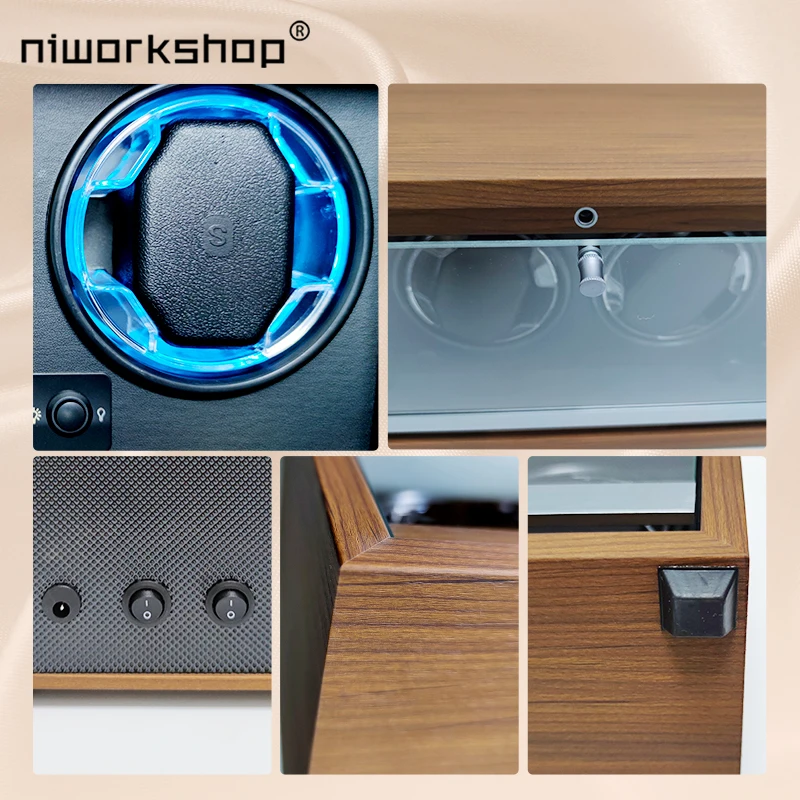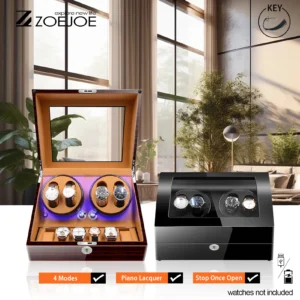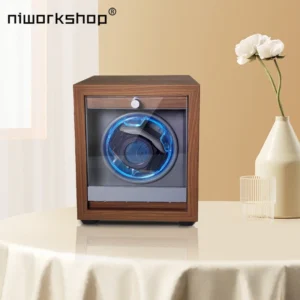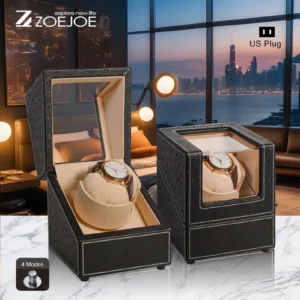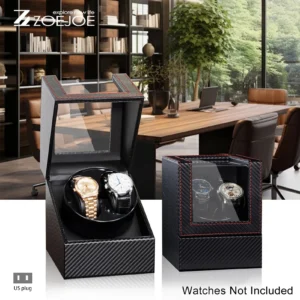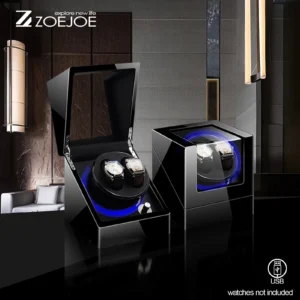Understanding Automatic Watch Winders and Their Importance
Automatic watch winders are sophisticated mechanical devices designed to simulate the natural movement of your wrist, keeping your self-winding timepieces running smoothly when they’re not being worn. These clever instruments work by rotating your watch in controlled patterns, engaging the internal rotor that powers the automatic movement.
The mechanics behind automatic watches are fascinating yet straightforward. These timepieces contain a semi-circular weight (the rotor) that rotates freely when the watch is in motion. As this rotor spins, it winds the mainspring, storing energy that powers the watch. Without regular movement, this energy reserve depletes, causing the watch to stop.
Using a quality watch winder offers numerous benefits for automatic watch owners:
- Maintains proper lubrication distribution throughout the movement
- Preserves accuracy of time and date functions
- Extends the lifespan of delicate mechanical components
- Provides the convenience of having your watches ready to wear anytime
What many watch enthusiasts don’t realize is that proper watch collection storage planning involves more than just keeping timepieces in a box. The adjustable cycle features found in quality winders are critically important because different watch movements have vastly different winding requirements. A one-size-fits-all approach simply doesn’t work for fine timepieces.
The technical differences between various watch movements mean that using inappropriate winding settings can potentially cause inefficient winding or unnecessary wear. This is why understanding how to properly use the adjustable features of watch winders is essential for any serious watch collector.
Decoding Turns Per Day (TPD): The Fundamental Setting
Turns Per Day (TPD) represents the most critical setting on any automatic watch winder. This number indicates exactly how many complete rotations the winder performs in a 24-hour period. Think of it as the “dosage” of movement your watch receives daily.
Setting the correct TPD is crucial for several key reasons:
- Too few rotations may fail to adequately wind the mainspring, resulting in insufficient power reserve
- Excessive rotations can create unnecessary movement and potential wear on components
- Proper TPD settings ensure optimal mainspring tension without overstressing the mechanism
Different watch movements are engineered with specific winding requirements, generally falling into these categories:
- Low range (650-800 TPD): Common for many vintage watches and some modern designs that require minimal winding
- Medium range (800-1000 TPD): The most common requirement for standard Swiss and Japanese movements
- High range (1000+ TPD): Required for complex movements or those with extended power reserves
Understanding TPD settings for watch winders becomes especially important when you realize the wide variation across manufacturers. For instance, many basic ETA movements require around 650-800 TPD, while some Rolex calibers need 650-950 TPD, and certain Seiko movements function best at 800-850 TPD.
| Movement Manufacturer | Typical TPD Range | Common Models |
|---|---|---|
| ETA | 650-800 | 2824-2, 2892 |
| Rolex | 650-950 | 3135, 3235 |
| Seiko | 800-850 | 6R15, 4R36 |
| Miyota | 650-800 | 9015, 8215 |
| Omega | 800-900 | 8500, 8900 |
When uncertain about the ideal TPD for your specific timepiece, consult the manufacturer’s documentation or inquire with an authorized service center. Setting your automatic watch winder correctly ensures your timepiece receives precisely the care it needs.
Rotation Direction Settings: Beyond Basic Winding
Moving beyond simple turns per day, rotation direction represents another crucial adjustable feature in quality watch winders. Most premium winders offer three directional settings:
- Clockwise (CW): The winder rotates only in a right-hand direction
- Counter-clockwise (CCW): The winder rotates only in a left-hand direction
- Bi-directional: The winder alternates between clockwise and counter-clockwise rotations
The importance of direction settings stems from the fundamental design of automatic movements. Different watch manufacturers engineer their rotors to wind in specific ways. Some movements wind most efficiently when the rotor moves in one particular direction, while others are designed to harness energy from bi-directional motion.
Using an incorrect rotation direction can result in inefficient winding, where your watch may not receive enough power despite being in the winder for sufficient time. This is particularly important for watches with specialized or vintage movements.
Determining the optimal direction for your specific watch can be accomplished through several methods:
- Consulting the watch’s technical manual or manufacturer’s website
- Researching the specific caliber number of your movement
- Observing the rotor’s movement through the display caseback (if available)
When in doubt about the exact requirements, bi-directional rotation typically provides the safest option for most modern watches, as it mimics the natural variety of wrist movements.
| Watch Brand | Common Winding Direction |
|---|---|
| Rolex | Bi-directional |
| Omega | Bi-directional |
| Seiko | Bi-directional |
| Tudor | Bi-directional |
| Patek Philippe | Clockwise predominant |
| Audemars Piguet | Bi-directional |
Understanding proper watch winder TPD settings and rotation direction ensures that your timepiece receives movement that closely mimics natural wear patterns, helping maintain optimal performance over time.
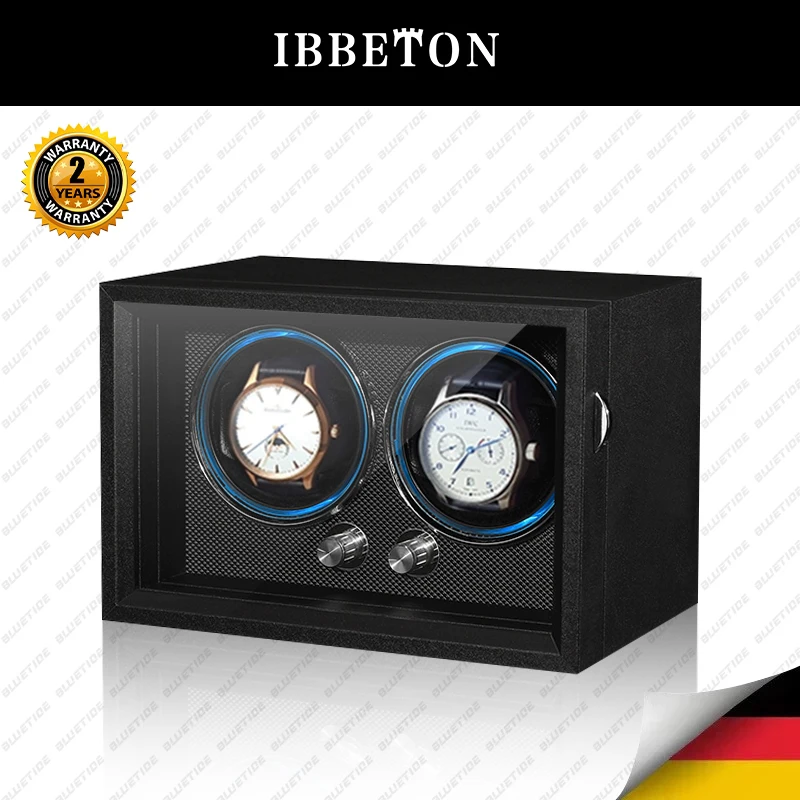
Rest Periods and Intermittent Winding: Mimicking Natural Wear
One of the most sophisticated yet often overlooked features in premium watch winders is the ability to program rest periods into winding cycles. This intermittent winding approach creates pauses between active rotation periods, and it’s far more beneficial than continuous motion.
Rest periods in winding cycles offer several important advantages:
- They better simulate actual human wearing patterns (we don’t move constantly throughout the day)
- Reduce unnecessary stress on the watch’s mechanical components
- Help prevent potential overwinding concerns in sensitive movements
- Extend the operational life of the winder motor itself
A quality winder typically alternates between active winding phases (minutes of rotation) and programmed rest periods (hours of stillness). This rhythm much more accurately replicates how a watch would experience motion when worn on your wrist during daily activities.
Consider a typical day: you might be active for a few hours, then sitting still while working, then active again. A winder with programmable rest periods can create a similar pattern—perhaps 2 hours of intermittent rotation followed by 6 hours of rest.
It’s worth addressing the common “overwinding myth” that concerns many collectors. Modern automatic watches contain a slipping mechanism (often called a bridle) that prevents true overwinding of the mainspring. However, constant motion without rest isn’t how these timepieces were designed to function, which is why luxury watch winders with programmable rest periods offer superior care.
For example, a watch normally worn 8 hours per day might only experience about 4-5 hours of actual motion. A sophisticated winder can replicate this natural pattern rather than subjecting the watch to continuous rotation, which no timepiece would experience during normal wear.
Advanced Programmable Features in Premium Winders
As you explore higher-end watch winders, you’ll discover a world of sophisticated programmable features that elevate watch care to new levels. These advanced capabilities go far beyond basic TPD and direction settings, offering unprecedented control over how your timepieces are maintained.
Premium winders may include several cutting-edge features:
- Start delay functions that allow you to set a specific time before winding begins
- Multi-program settings capable of storing different configurations for various watches
- Custom winding schedules that operate only during certain days or hours
- Sleep mode options that minimize power consumption during inactive periods
Many advanced units include LED indicators or digital displays that provide clear visual confirmation of current settings. This instant feedback makes programming simpler and helps ensure your watches receive precisely the care you intend.
Modern connectivity features are also becoming increasingly common in high-end winders:
- App control capabilities allow remote adjustment of settings
- Programmable weekly schedules can vary winding patterns based on your wearing habits
- Memory functions store optimal settings for different watch brands and models
These sophisticated features are particularly valuable when organizing your watch collection, as they allow each timepiece to receive individualized care despite being part of a larger storage system. For serious collectors with multiple fine watches, this level of customization ensures each piece maintains optimal performance.
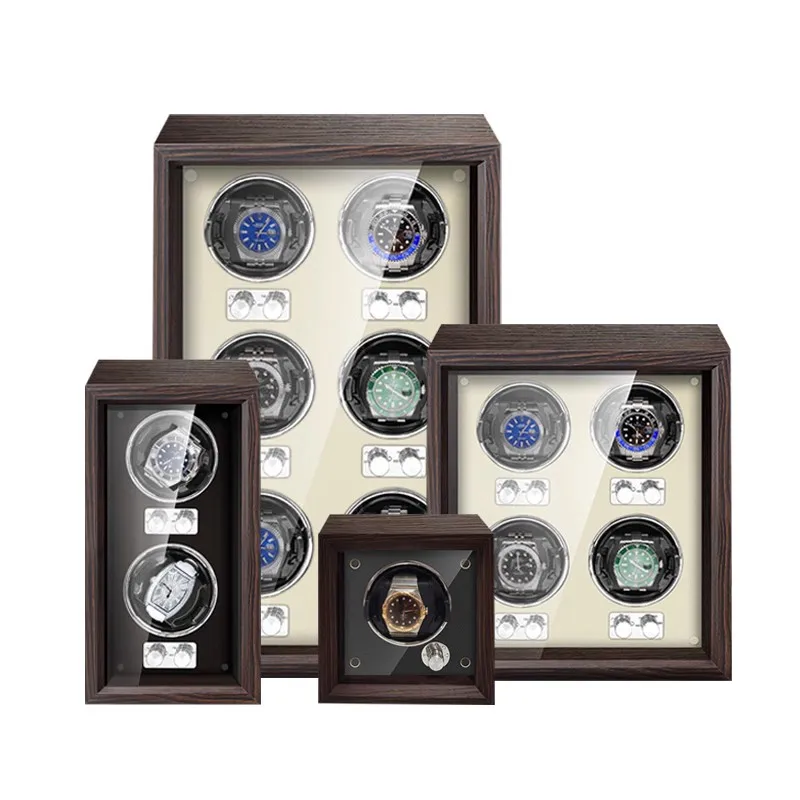
Setting Up Your Winder: Step-by-Step Configuration Guide
Configuring your automatic watch winder correctly ensures your timepieces receive optimal care. Follow these steps to properly set up your winder for any watch in your collection:
Consult the winder’s instruction manual – Each brand and model has unique controls and capabilities. Familiarize yourself with your specific unit’s interface before proceeding.
Determine your watch’s requirements – Identify the recommended TPD and rotation direction for your specific watch model and movement. This information is available from the watch manufacturer or reliable online resources.
Locate and understand the control mechanisms – Identify how to adjust settings on your particular winder. Controls may include physical dials, buttons, switches, or digital interfaces.
Set the TPD parameter first – This is the most fundamental setting. Select the appropriate number of turns per day based on your watch’s requirements.
Select the appropriate rotation direction – Choose clockwise, counter-clockwise, or bi-directional rotation according to your watch’s movement design.
Configure rest periods if available – If your winder offers intermittent winding capabilities, set appropriate active and rest intervals to mimic natural wearing patterns.
Test and monitor your watch’s response – After 24-48 hours, check if your watch maintains good time and power reserve. Make adjustments if necessary.
When setting up your winder, avoid these common mistakes: using arbitrary settings without researching your watch’s needs, setting TPD excessively high “just to be safe,” or forgetting to secure the watch properly in the holder.
Understanding best automatic watch winder settings for your specific timepieces will help you maintain your watches in optimal condition. Remember that proper configuration isn’t just about keeping the watch running—it’s about providing the ideal conditions for long-term mechanical health.
Multiple Watch Considerations: Managing Diverse Collections
Managing a varied watch collection presents unique challenges when it comes to winding requirements. Different movements often need different settings, creating potential complications for the serious collector.
Watch enthusiasts with diverse collections have several strategies available:
Individual single-watch winders – This approach allows complete customization of settings for each timepiece but requires more space and investment.
Multi-watch winders with independently programmable modules – These sophisticated units allow different settings for each position, making them ideal for varied collections.
Rotation schedules – For collectors with more watches than winder positions, creating a schedule to rotate different watches through the winder can ensure all pieces receive periodic movement.
When deciding which watches should remain in winders continuously, consider factors such as complexity (chronographs and calendar complications benefit from constant running), frequency of wear, and difficulty of resetting (perpetual calendars, for example).
The significant advantage of 4-watch winders with individually adjustable modules is the ability to care for several different watch types simultaneously without compromise. A collector might have a Rolex requiring 650 TPD bidirectional, alongside an Omega needing 800 TPD, a vintage piece requiring gentler winding, and a complicated watch benefiting from continuous operation—all with appropriate settings in a single unit.
This customized approach ensures each timepiece receives precisely the care it needs, regardless of the diversity within your collection.
How to Choose a Winder with Optimal Adjustable Features
Selecting a watch winder with the right mix of adjustable features requires careful consideration of several key factors. The ideal winder provides the versatility to care for your current collection while accommodating future acquisitions.
When evaluating watch winders, prioritize these critical adjustable features:
TPD range and precision – Look for winders offering a wide range (ideally 300-1200+ TPD) with multiple incremental settings rather than just a few preset options.
Comprehensive rotation direction options – Ensure the winder provides clockwise, counter-clockwise, and bi-directional settings.
Rest period programmability – Quality winders allow you to set intermittent winding patterns rather than continuous rotation.
Interface accessibility – Controls should be intuitive and easy to adjust, whether through physical dials or digital interfaces.
Motor quality and noise level – Premium winders use Japanese motors known for quiet operation and longevity.
Construction materials – Look for solid wood cabinets, quality finishes, and soft interior materials that won’t scratch watch cases or bracelets.
While budget considerations are inevitable, view a quality winder as an investment rather than an expense. Given that automatic watches can cost thousands of dollars, proper care through a winder with comprehensive adjustable features helps protect that investment over many years.
Implementing thoughtful watch storage ideas for collectors often includes integrating quality winders into your overall solution. For those with growing collections, double watch winders offer a good balance of functionality and value, providing individualized care for two timepieces while occupying minimal space.
Automatic Watch Winder, Luxury Watch Winder, Single Watch Box
$307.39 Select options This product has multiple variants. The options may be chosen on the product page4 Watch Winder, 6 Watch Box, Automatic Watch Winder
$512.31 Select options This product has multiple variants. The options may be chosen on the product pageAutomatic Watch Winder, Single Watch Winder, Wooden Watch Holder
$201.76 Select options This product has multiple variants. The options may be chosen on the product pageAutomatic Watch Winder, Leather Watch Travel Case, Single Watch Winder
$146.30 Select options This product has multiple variants. The options may be chosen on the product pageAutomatic Watch Winder, Double Watch Winder, Leather Watch Boxes
$147.60 Select options This product has multiple variants. The options may be chosen on the product pageAutomatic Watch Winder, Double Watch Winder
$206.18 Select options This product has multiple variants. The options may be chosen on the product page
The long-term benefits of investing in adjustable features become apparent through extended watch performance and reduced service needs—making quality winders a wise choice for the discerning collector.
Troubleshooting Winder Setting Problems
Even with careful configuration, watch winder issues occasionally arise. Understanding how to diagnose and address common problems ensures your timepieces receive optimal care.
Problem: Watch not maintaining power reserve despite being in the winder
Possible causes: TPD setting too low; incorrect rotation direction; watch not properly secured in cushion
Solution: Increase TPD setting incrementally; verify correct rotation direction for your specific movement; ensure the watch is firmly secured but not compressed in the holder
Problem: Watch running significantly fast or slow after winding periods
Possible causes: Excessive TPD causing overwinding symptoms; watch may need service
Solution: Reduce TPD setting; if problem persists, have watch examined by a professional
Problem: Watch not winding despite being in winder
Possible causes: Winder malfunction; watch rotor issue; improper watch positioning
Solution: Test winder with another watch to isolate the problem; check that watch sits properly in holder with crown in recommended position
Problem: Unusual noises during winding cycles
Possible causes: Mechanical issue with winder motor; loose components; watch bracelet rattling
Solution: Ensure watch is properly secured; check for loose parts in winder; contact manufacturer if motor issues persist
Problem: Watch falling out of cushion during rotation
Possible causes: Incorrect cushion size; improper securing technique
Solution: Use cushion adapters if available; adjust cushion compression; consider alternative strap/bracelet position
Understanding when to use or not use watch winders helps identify whether winding issues stem from settings or from watches that might be better stored statically. Some vintage pieces or watches with unusual power systems may not respond well to standard winding patterns, regardless of adjustable settings.
If problems persist after adjusting settings, consider contacting the winder manufacturer for model-specific guidance or consulting with a watchmaker about your specific timepiece’s needs.
The Importance of Regular Setting Reviews
Watch winder settings shouldn’t be treated as “set and forget” configurations. Regular reviews of your winding parameters ensure continued optimal performance as watches and winders age.
Several factors make periodic setting reviews essential:
- Watch movements can change performance characteristics as they age
- Seasonal temperature and humidity variations can affect winding efficiency
- Service interventions may alter a watch’s winding requirements
- New information about optimal settings for specific models becomes available over time
A good practice is to evaluate winder settings quarterly, after any watch servicing, or whenever you notice changes in your watch’s performance. Look for these indicators that settings might need adjustment:
- Decreased power reserve despite consistent winder use
- Significant timing variations not present previously
- Unusual sounds from the watch movement
- Changes in how quickly the watch winds when worn naturally
The relationship between a watch and its winder is dynamic, requiring occasional attention to maintain optimal results. By treating winder configuration as an ongoing process rather than a one-time setup, you ensure your single watch winders and multi-position units continue providing ideal care for your timepieces throughout their lifetime.
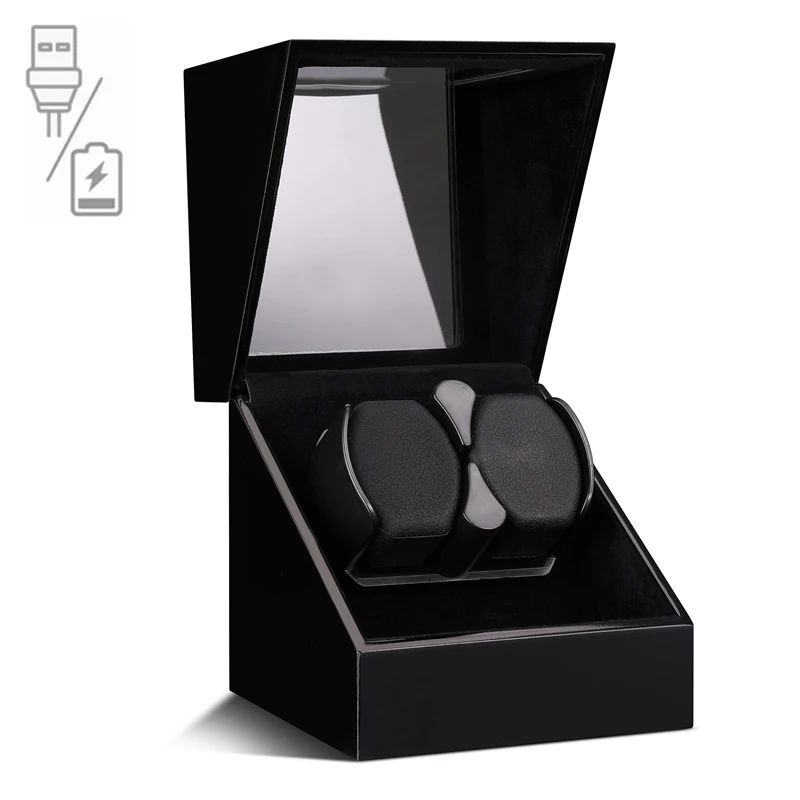
Are Adjustable Features Worth the Investment?
When considering watch winder options, you’ll face a fundamental question: Are advanced adjustable features worth the higher price compared to basic, fixed-setting models?
Advantages of fully adjustable winders:
– Precision care tailored to each specific watch movement
– Flexibility to accommodate diverse watch collections
– Ability to adapt to changes in watch performance over time
– Reduced risk of improper winding leading to service needs
When simpler winders might suffice:
– For collections where all watches have similar winding requirements
– When caring for robust modern movements less sensitive to winding variations
– For occasional use with watches worn regularly
– When budget constraints are significant
Adjustable features become especially valuable—even essential—in several scenarios. Vintage timepieces with delicate movements often require precise, gentle winding patterns unavailable on basic units. Diverse collections with watches from multiple manufacturers benefit from customized settings for each piece. Serious collectors investing significantly in their timepieces gain peace of mind knowing each watch receives optimal care.
For most collectors, the value proposition becomes clear when considering the cost of premium watches themselves. When protecting timepieces worth thousands or tens of thousands of dollars, investing in proper luxury watch storage setups with quality winders represents a small percentage of the collection’s value while helping preserve that value long-term.
Daily Accents offers winder options across the spectrum, from basic functionality to advanced programmability, allowing collectors to select the level of adjustability that best suits their specific collection needs.
Future Trends in Watch Winder Technology
The world of watch winders continues to evolve with innovative technologies that promise even more sophisticated care for fine timepieces. Several emerging developments are worth watching for serious collectors.
Advanced sensor technologies are beginning to appear in premium winders, with capabilities to detect and analyze a watch’s winding efficiency. These smart systems can potentially adjust rotation patterns automatically based on how a particular watch responds to different settings.
Integration with smartphone apps is becoming increasingly common, allowing remote monitoring and adjustment of winder settings. Some systems can even track your wearing habits and automatically optimize winding cycles to complement your patterns of use.
Future winders may incorporate learning algorithms that analyze watch behavior over time, fine-tuning parameters for truly individualized care. This represents a significant advance over today’s manually programmed settings.
Despite these technological advances, the fundamental importance of adjustable features remains constant. In fact, new developments primarily serve to make adjustments more precise and user-friendly rather than eliminating the need for customization.
Understanding the technological foundations of various types of motors in watch winders helps collectors appreciate how these advances build upon established engineering principles to provide increasingly refined care for valuable timepieces.
As watch winder technology continues advancing, the goal remains unchanged: providing optimal mechanical conditions that maintain accuracy and extend the life of fine automatic watches through precisely tailored motion.

